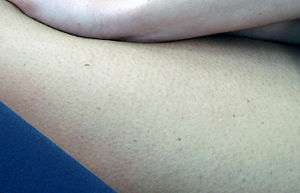Lentigo
| Lentigo | |
|---|---|
 | |
| A mild form of lentigo simplex | |
| Classification and external resources | |
| Specialty | family medicine |
| ICD-10 | L81.4 |
| ICD-9-CM | 709.09 |
| DiseasesDB | 34325 |
| eMedicine | derm/221 |
| Patient UK | Lentigo |
| MeSH | D007911 |
A lentigo (/lɛnˈtaɪɡoʊ/) (plural lentigines, /lɛnˈtɪdʒᵻniz/) is a small pigmented spot on the skin with a clearly defined edge, surrounded by normal-appearing skin. It is a harmless (benign) hyperplasia of melanocytes which is linear in its spread. This means the hyperplasia of melanocytes is restricted to the cell layer directly above the basement membrane of the epidermis where melanocytes normally reside. This is in contrast to the "nests" of multi-layer melanocytes found in moles (melanocytic nevi). Because of this characteristic feature, the adjective "lentiginous" is used to describe other skin lesions that similarly proliferate linearly within the basal cell layer.[1][2]
Lentigines are distinguished from freckles (ephelis) based on the proliferation of melanocytes. Freckles have a relatively normal number of melanocytes but an increased amount of melanin. A lentigo has an increased number of melanocytes. Freckles will increase in number and darkness with sunlight exposure, whereas lentigines will stay stable in their color regardless of sunlight exposure.[2]
Conditions characterized by lentigines include:[3]:686–687
- Lentigo simplex
- Solar lentigo (Liver spots)
- PUVA lentigines
- Ink spot lentigo
- LEOPARD syndrome
- Mucosal lentigines
- Multiple lentigines syndrome
- Moynahan syndrome
- Generalized lentiginosis
- Centrofacial lentiginosis
- Carney complex
- Inherited patterned lentiginosis in black persons
- Partial unilateral lentiginosis
- Peutz-Jeghers syndrome
- Lentigo maligna
- Lentigo maligna melanoma
- Acral lentiginous melanoma
See also
References
- ↑ Random House Webster's Unabridged Dictionary. Random House, Inc. 2001. Page 1101. ISBN 0-375-72026-X.
- 1 2 Robbins and Cotran Pathologic Basis of Disease Elsevier. 2005. Page 1232. ISBN 0-8089-2302-1 .
- ↑ William D. James; Timothy G. Berger; et al. (2006). Andrews' Diseases of the Skin: Clinical Dermatology. Saunders Elsevier. ISBN 0-7216-2921-0.